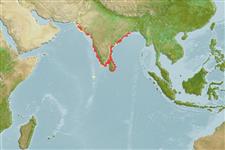Environment: milieu / climate zone / depth range / distribution range
Ecologia
marino; salmastro; amfidromo (Ref. 51243); distribuzione batimetrica 0 - 50 m (Ref. 189). Tropical; 26°N - 5°N, 64°E - 95°E (Ref. 189)
Indian Ocean: India, perhaps reaching to Pakistan, but not recorded from the Gulf and the Red Sea, its place in the Gulf being taken by Thryssa whiteheadi.
Size / Peso / Age
Maturity: Lm ? range ? - ? cm
Max length : 17.5 cm SL maschio/sesso non determinato; (Ref. 189)
Short description
Chiavi di identificazione | Morfologia | Morfometria
Spine dorsali (totale) : 0; Spine anali: 0; Raggi anali molli: 34 - 38. Belly with 23 to 26 keeled scutes (isthmus to anus). Tip of snout about level of upper rim of eye. Maxilla moderate; first supra-maxilla small, oval; jaw teeth small. A dark blotch behind upper part of gill opening; small spots on cheek, gill cover, maxilla and paired fins; gill arches pinky orange, inside of gill cover yellow and gold; inner part of anal fin deep yellow, margin whitish.
A schooling fish found mostly inshore and perhaps entering estuaries. Although the name malabarica features in the literature, there can be no certainty that it refers to present species.
Life cycle and mating behavior
Maturities | Riproduzione | Spawnings | Egg(s) | Fecundities | Larve
Whitehead, P.J.P., G.J. Nelson and T. Wongratana, 1988. FAO Species Catalogue. Vol. 7. Clupeoid fishes of the world (Suborder Clupeoidei). An annotated and illustrated catalogue of the herrings, sardines, pilchards, sprats, shads, anchovies and wolf-herrings. FAO Fish. Synop. 125(7/2):305-579. Rome: FAO. (Ref. 189)
IUCN Red List Status (Ref. 130435)
Threat to humans
Harmless
Human uses
Pesca: commerciale
Strumenti
Special reports
Download XML
Fonti Internet
Estimates based on models
Preferred temperature (Ref.
123201): 26.3 - 28.6, mean 27.5 °C (based on 76 cells).
Phylogenetic diversity index (Ref.
82804): PD
50 = 0.5000 [Uniqueness, from 0.5 = low to 2.0 = high].
Bayesian length-weight: a=0.00380 (0.00221 - 0.00653), b=3.11 (2.96 - 3.26), in cm total length, based on LWR estimates for this species & Genus-body shape (Ref.
93245).
Trophic level (Ref.
69278): 3.4 ±0.5 se; based on size and trophs of closest relatives
Resilienza (Ref.
120179): Alto, tempo minimo di raddoppiamento della popolazione meno di 15 mesi (Preliminary K or Fecundity.).
Fishing Vulnerability (Ref.
59153): Low vulnerability (11 of 100).
